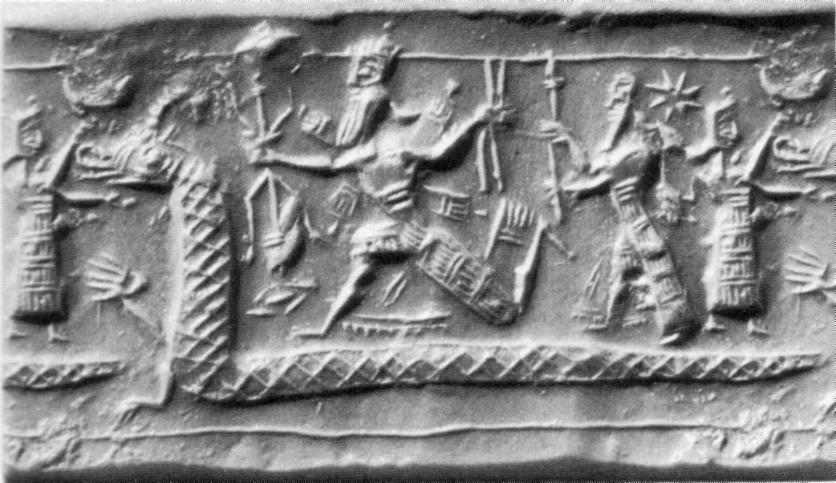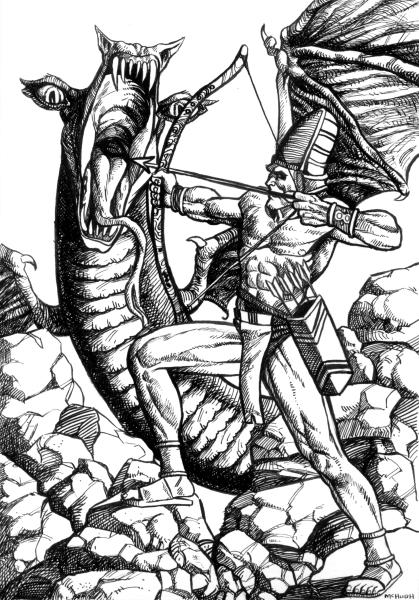Most of what we know about Tiamat comes from the Enuma Elish, the Babylonian creation myth. This was probably written in the 18th to 16th centuries BCE, though the oral tradition is far older. The name is cognate with the Greek Thalassa (Θάλασσα, "sea"), who was a primordial sea goddess in Greek mythology. We know very little about Thalassa as first the Titans (sharing the same root as the Canaanite gods, from which the biblical God is derived) and then Olympian gods replaced the older ones, pushing them from the limelight and often taking on many of their traits.
Tiamat was probably originally a mother goddess or creatrix, creating the world through the mingling of salt and fresh water peacefully over many generations. She shares a root with the other mother goddesses of the world. However, as new gods came in and people moved from place to place, she took on the aspect of a chaos monster- a monstrous embodiment of primordial chaos, who caused the world to come to be but opposed order. She shares some traits with the Norse Ymir, as both their bodies were taken apart by the younger gods to make the world.

In the Enuma Elish, Tiamat and the embodiment of fresh water, Apsu, mingle to produce Lahmu and Lahamu, probably personifications of mud and silt. These two then gave birth to Anshar, the sky, and Kishar, the earth. They met on the horizon and there produced the gods Anu and Ki. From them came the other gods, who rapidly grew in number.
Apsu and his vizier Mummu were irritated by the younger gods, and held council with Tiamat to decide what to do about it. Though she was against it, they planned to destroy the younger gods. However, the god Enki learnt of his plans and killed him, creating his temple E-Apsu from the remains. Kingu, son of Tiamat and Apsu, reported this to his mother.
Enraged, Tiamat gave birth to an enormous host of monsters, including sea serpents, demons, fishmen, scorpion men, hurricanes, godlike dragons and eleven particularly powerful monsters. She gave Kingu generalship and gave him the Tablets of Destiny to wear- whoever possessed the Tablets of Destiny had their word become law in the universe, becoming nigh-omnipotent. The gods were terrified and gathered, offering particular honour to any who could face and kill Tiamat.
Anshar sent Enki to fight Tiamat, but once he saw her army and her plots he found himself unable to continue, and went back having failed. Anshar then sent Anu out, but he was similiarly dismayed.
However, Anu suggested that they should send Marduk to fight Tiamat. Marduk was Enki's son, and a god of storms and war. He agreed to go against Tiamat if he was given kingship over all the gods as a reward. They agreed, and Marduk created many storms then rode out in his storm chariot with his weapons. He tied up the horde in a giant net and took the Tablets of Destiny from Kingu, then put them on himself. He fought Tiamat and resisted her spells, filling her with hurricanes then stabbing her, killing her.
He then broke apart her body and used it to create the world, one half as the heavens and the other the Earth. The tears from her eyes became the great rivers of the Tigris and Euphrates, her tail became the Milky Way, and her ribs formed the vault of heaven and earth.
Robert Graves considered Tiamat's death by Marduk as evidence of his hypothesis that a shift in power from a matriarchy controlling society to a patriarchy happen in the ancient past. Grave's ideas were later developed into the Great Goddess theory by Marija Gimbutas, Merlin Stone and others. Tiamat and other ancient monster figures were presented as former supreme deities of peaceful, woman-centered religions that were turned into monsters when violent, male-dominated religions overthrew ancient society. -Wikipedia The Tiamat myth is one of the earliest recorded versions of the Chaoskampf, the battle between a culture hero and a chthonic or aquatic monster, serpent or dragon. Chaoskampf motives in other mythologies linked directly or indirectly to the Tiamat myth include the Hittite Illuyanka myth, and in Greek tradition Apollo's killing of the Python as a necessary action to take over the Delphic Oracle. -Wikipedia |  |
Tiamat also has been claimed to be cognate with Northwest Semitic tehom (תהום) (the deeps, abyss), in the Book of Genesis 1:2.